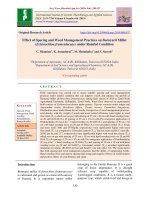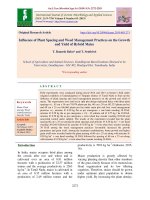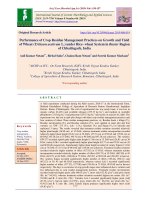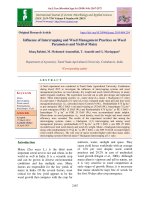Influence of weed management practices on uptake of nutrients by kharif sorghum [Sorghum bicolor (L.) Moench] and its effect on soil fertility status
Bạn đang xem bản rút gọn của tài liệu. Xem và tải ngay bản đầy đủ của tài liệu tại đây (180.53 KB, 7 trang )
Int.J.Curr.Microbiol.App.Sci (2019) 8(10): 261-267
International Journal of Current Microbiology and Applied Sciences
ISSN: 2319-7706 Volume 8 Number 10 (2019)
Journal homepage:
Original Research Article
/>
Influence of Weed Management Practices on Uptake of Nutrients by
Kharif Sorghum [Sorghum bicolor (L.) Moench] and its
Effect on Soil Fertility Status
S. S. Vinayaka1, D. Krishnamurthy1*, A. S. Channabasavanna2,
Y. M. Ramesha3 and Manjunath Bhanuvalli4
1
2
Department of Agronomy, AICRP on Sorghum, ARS, Hagari, India
Department of Agronomy, Directorate of Research, UAS, Raichur, India
3
Department of Agronomy, ARS, Dhadesugur, India
4
Department of Soil Science, Agricultural Extension Education Centre,
Hadagali, University of Agricultural Sciences, Raichur-584 104, India
*Corresponding author
ABSTRACT
Keywords
Polebean, Tillage,
Nutrient uptake and
microbial
population
Article Info
Accepted:
04 September 2019
Available Online:
10 October 2019
A field experiment was conducted at Agricultural Research Station, Hagari, Ballari during
Kharif season of 2018on deep black soil. The experiment was laid out in randomized block
design and repeated thrice with twelve treatments. Significantly higher uptake of nitrogen,
phosphorus and potassium (219, 56.5 and 147.4 kg ha -1) was recorded with atrazine 50 WP
@ 0.50 a.i. kg ha-1fb 2,4-D Ethyl Ester 38 EC @ 0.90 a.i. kg ha -1 as PoE at 30 DAS and it
was on par with hand weeding at 20 DAS and 1 IC at 40 DAS (215, 55.2, and 145.7 kg
ha-1, respectively) and 2,4-D Ethyl Ester 38 EC @ 0.90 kg a.i. ha-1 as PoE at 30 DAS fb 1
IC at 40 DAS (211, 54.9, and 143.7 kg ha -1, respectively. Nitrogen, phosphorous and
potassium availability in the soil was significantly higher with weed free (IC at 20 & 40
DAS and HW at 30 DAS) (194, 47.6, and 219.9 kg ha-1, respectively) treatment. Among
other weed management practices, sequential pre-emergence application of atrazine 50 WP
@ 0.50 kg a.i. ha-1 fb 2,4-D Ethyl Ester 38 EC @ 0.90 kg a.i. ha-1 as PoE at 30 DAS
recoded significantly higher availability of nitrogen, phosphorous and potassium in the soil
(177, 42.2, and 213.8 kg ha-1, respectively) and it was on par with hand weeding at 20
DAS and 1 IC at 40 DAS (173, 41.7, and 212.1 kg ha-1, respectively) and 2,4-D Ethyl
Ester 38 EC @ 0.90 kg a.i. ha-1 as PoE at 30 DAS fb 1 IC at 40 DAS (170, 39.9, and 211.9
kg ha-1, respectively).
Introduction
Sorghum is one of the important dryland crop
grown in poor lands with minimum inputs and
in dry conditions that tolerate to heat, salt and
water-logging. Sorghum is a preferred in
tropical, warm and semiarid regions of the
world with high temperature and water stress
261
Int.J.Curr.Microbiol.App.Sci (2019) 8(10): 261-267
with the threat of climate change looming
large on the crop productivity, sorghum is
hardy crop that plays an important role in
food, feed and fodder security in dryland
economy (Paterson et al., 2009). Sorghum is a
smart crop capable of providing raw material
for the making of starch, fibre, dextrose syrup,
biofuels, alcohol and other goods especially
under moderate inputs and water deficit
environments (Mehmood et al., 2008).
Ever increasing use of fertilizers and irrigation
water, weed management has assumed
significant importance in modern intensive
farming, as the total loss of crop yield with
increasing cost of cultivation causes a greater
economic loss to the farmers (Aravadiya et al.,
2012).
The extent of yield loss due to weeds
primarily depends on the composition of weed
flora, period of crop-weed-competition and its
intensity. Weeds reduce the crop yields crop
yield by competing with light, water, nutrients
and carbon dioxide. Effect of weeds and weed
management on uptake of nutrients and its
effect on soil fertility status is scanty.
Therefore present experiment was planned to
study the Influence of weed management
practices on uptake of nutrients by kharif
sorghum and its effect on soil fertility status.
Materials and Methods
A field experiment entitled “Influence of weed
management practices on uptake of
nutrientsby kharif sorghum [Sorghum bicolor
(L.) Moench] and its effect on soil fertility
status” was conducted at Agricultural
Research Station, Hagari, Ballari during kharif
2018. Agricultural Research Station, Hagari,
Ballari is located on 15o 14' N latitude and 77o
07' E longitude with an altitude of 414 meters
above the mean sea level and is located in
Northern Dry Zone of Karnataka (Zone-III).
The soil of the experimental field was clayey
in texture. The soil available nutrient status
showed medium availability of nitrogen
(262.00 kg ha-1), medium in available
phosphorus (39.25 kg ha-1) and high in
available potassium (307.00 kg ha-1). The
organic carbon content was low to medium
(5.1 g kg-1). Twelve treatments comprising of
weed management practices viz., T1: Atrazine
50 WP @ 0.50 kg a.i. ha-1 as PE, T2: Atrazine
50 WP @ 0.50 kg a.i. ha-1 as PE fb 1 IC at 40
DAS, T3: Pendimethalin 38.7 CS @ 0.6773 kg
a.i. ha-1 as PE, T4: Pendimethalin 38.7 CS @
0.6773 kg a.i. ha-1 as PE fb 1 IC at 40 DAS,
T5: Atrazine 50 WP @ 0.25 kg a.i. ha-1 +
Pendimethalin 38.7 CS @ 0.3387 kg a.i. ha-1
(Tank mix) as PE, T6: Atrazine 50 WP @ 0.25
kg a.i. ha-1 + Pendimethalin 38.7 CS @ 0.3387
kg a.i. ha-1 (Tank mix) as PE fb 1 IC at 40
DAS, T7: 2,4-D Ethyl Ester 38 EC @ 0.90 kg
a.i. ha-1 as PoE at 30 DAS, T8: 2,4-D Ethyl
Ester 38 EC @ 0.90 kg a.i. ha-1 as PoE at 30
DAS fb 1 IC at 40 DAS, T9: Atrazine 50 WP
@ 0.50 kg a.i. ha-1 as PE fb 2,4-D Ethyl Ester
38 EC @ 0.90 kg a.i. ha-1 as PoE at 30 DAS,
T10: Hand weeding at 20 DAS and 1 IC at 40
DAS, T11: Weed free (IC at 20 & 40 DAS and
HW at 30 DAS), T12: Weedy check were
evaluated in randomized block design with
three replications.
The composite soil samples from 0 to 15 cm
depth were collected before planting and at
harvest. Soils were air dried in shade,
powdered and passed through 2 mm sieve and
analysed for pH, EC, OC, available N, P2O5
and K2O5by following the methods described
by Jackson (1973).The seeds of CSH-25 @
7.5 kg ha-1 were sown at the spacing of 45 cm
X 15 cm and the recommended package of
practices were adopted for crop production.
The crop was harvested at its physiological
maturity. The data was statistically analysed
as per the procedure given by Panse and
Sukhatme (1967).
262
Int.J.Curr.Microbiol.App.Sci (2019) 8(10): 261-267
Results and Discussion
Uptake of nutrients
Significantly higher nitrogen, phosphorus and
potassium uptake (219, 56.5 and 147.4 kg ha-1,
respectively) was recorded with preemergence application of atrazine 50 WP @
0.50 kg a.i. ha-1fb 2,4-D Ethyl Ester 38 EC @
0.90 kg a.i. ha-1 as PoE at 30 DAS and it was
on par with hand weeding at 20 DAS and 1 IC
at 40 DAS (215, 55.2, and 145.7 kg ha-1,
respectively) and 2,4-D Ethyl Ester 38 EC @
0.90 kg a.i. ha-1 as PoE at 30 DAS fb 1 IC at
40 DAS (211, 54.9, and 143.7 kg ha-1,
respectively) (Table 1). Whereas, significantly
lower uptake of nitrogen, phosphorus and
potassium was observed with weedy check
(129, 35.7 and 95.4 kg ha-1, respectively) as
compared to other treatments (Table 2).
This is due to lower crop weed competition
results in better dry matter production in crop
this ultimately results in higher uptake of
nutrients. Whereas, the lowest uptake of
nitrogen, phosphorus and potassium by maize
crop was recorded in unweeded control as a
result of weed competition resulting in lower
dry matter production.
These results corroborate the results of Priya
and Kubsad (2013) in sorghum and also by
Sreenivas and Satyanarayana (1994).
Soil fertility status
Nitrogen,
phosphorus
and
potassium
availability in the soil after harvest of kharif
sorghum crop was significantly influenced by
different weed management practices (Table
2).
Significantly higher available nitrogen,
phosphorus and potassium in the soil were
recorded with weed free (IC at 20 & 40 DAS
and HW at 30 DAS) (194, 47.6, and 219.9 kg
ha-1, respectively). Among other weed
management treatments, sequential application
of pre-emergence herbicide atrazine 50 WP @
0.50 kg a.i. ha-1fb 2,4-D Ethyl Ester 38 EC @
0.90 kg a.i. ha-1 as PoE at 30 DAS recorded
significantly higher availability of nitrogen,
phosphorus and potassium in the soil (177,
42.2, and 213.8 kg ha-1, respectively) and it
was on par with hand weeding at 20 DAS and
1 IC at 40 DAS (173, 41.7, and 212.1 kg ha-1,
respectively) and 2,4-D Ethyl Ester 38 EC @
0.90 kg a.i. ha-1 as PoE at 30 DAS fb 1 IC at
40 DAS (170, 39.9, and 211.9 kg ha-1,
respectively).
Significantly lower content of available
nitrogen, phosphorus and potassium was
noticed with weedy check (129, 26.9 and
152.0 kg ha-1, respectively) compared to other
treatments. These results are in corroboration
with findings of Verma et al., (2017).
Residual effect of herbicides on succeeding
chickpea crop
The germination percentage, plant height and
number of branches of chickpea were recorded
at 45 DAS and found that, treatments did not
differ significantly (Table 3). The sorghum chickpea is the prominent sequence in the
experimental area.
Hence, the residual effects of these treatments
were studied on chickpea by bioassay studies
(germination test) and the crop was examined
for its growth parameters like plant height and
branches in main field.
The data showed that non-significant
differences
between
chemical
weed
management practices and non-chemical
treated plots (hand weeding, weed free and
weedy check) indicating no adverse effect of
applied herbicides on succeeding crop and
confirmed no residual effect of the herbicides
tried in the experiment.
263
Int.J.Curr.Microbiol.App.Sci (2019) 8(10): 261-267
Table.1 Nitrogen, phosphorus and potassium uptake by kharif sorghum as influenced by different weed management practices
at harvest
Uptake of nutrients (kg ha-1)
Treatments
Nitrogen
Phosphorus
(P2O5)
Potassium
(K2O)
181
45.0
120.4
T2 : Atrazine 50 WP @ 0.50 kg a.i. ha as PE fb one IC at 40 DAS
204
49.0
138.2
T3 : Pendimethalin 38.7 CS @ 0.6773 kg a.i. ha-1 as PE
139
41.2
101.5
170
42.9
118.6
T5 : Atrazine 50 WP @ 0.25 kg a.i. ha + Pendimethalin 38.7 CS @ 0.3387 kg a.i. ha (Tank mix) as
PE
158
41.4
109.1
T6 : Atrazine 50 WP @ 0.25 kg a.i. ha-1 + Pendimethalin 38.7 CS @ 0.3387 kg a.i. ha-1 (Tank mix) as
PE fb one IC at 40 DAS
169
46.1
116.9
T7 : 2,4-D Ethyl Ester 38 EC @ 0.90 kg a.i. ha-1 as PoE at 30 DAS
191
48.4
125.3
211
54.9
143.7
T9 : Atrazine 50 WP @ 0.50 kg a.i. ha as PE fb 2,4-D Ethyl Ester 38 EC @ 0.90 kga.i. ha as PoE
at
30
DAS
219
56.5
147.4
T10 : HW at 20 DAS and one IC at 40 DAS
215
55.2
145.7
T11:Weed free (IC at 20 & 40 DAS and HW at 30 DAS)
235
61.9
159.4
T12:Weedy check
129
35.7
95.4
S.Em±
2.8
0.9
1.7
C.D. (P=0.05)
8.1
2.7
5.0
T1 : Atrazine 50 WP @ 0.50 kg a.i. ha-1 as PE
-1
-1
T4 : Pendimethalin 38.7 CS @ 0.6773 kg a.i. ha as PE fb one IC at 40 DAS
-1
-1
T8 : 2,4-D Ethyl Ester 38 EC @ 0.90 kg a.i.ha-1 as PoE at 30 DAS fb one IC at 40 DAS
-1
-1
Note:
WP: Wettable powder
PE: Pre-emergence
fb: Followed by
HW: Hand weeding
IC: Inter cultivation
DAS: Days after sowing
CS: Capsulated suspension
EC: Emulsified concentrate
264
PoE: Post emergence
Int.J.Curr.Microbiol.App.Sci (2019) 8(10): 261-267
Table.2 Effect of different weed management practices on available NPK content in soil after harvest of kharif sorghum
Available nutrients (kg ha-1)
Treatments
Nitrogen
Phosphorus
(P2O5)
Potassium
(K2O)
153
35.5
191.1
159
37.5
205.6
134
27.1
170.3
145
31.3
179.0
T5 : Atrazine 50 WP @ 0.25 kg a.i. ha + Pendimethalin 38.7 CS @ 0.3387 kg a.i. ha (Tank mix) as PE
141
30.0
174.3
T6 : Atrazine 50 WP @ 0.25 kg a.i. ha-1 + Pendimethalin 38.7 CS @ 0.3387 kga.i. ha-1 (Tank mix) as PE fb
one IC at 40 DAS
148
33.9
179.9
T7 : 2,4-D Ethyl Ester 38 EC @ 0.90 kg a.i. ha-1 as PoE at 30 DAS
155
37.1
194.4
170
39.9
211.9
T9 : Atrazine 50 WP @ 0.50 kg a.i. ha as PE fb 2,4-D Ethyl Ester 38 EC @ 0.90 kga.i. ha as PoE at 30
DAS
177
42.2
213.8
T10 : HW at 20 DAS and one IC at 40 DAS
173
41.7
212.1
T11:Weed free (IC at 20 & 40 DAS and HW at 30 DAS)
194
47.6
219.9
T12:Weedy check
129
26.9
152.0
S.Em±
2.6
1.5
1.3
C.D. (P=0.05)
7.6
4.4
3.8
T1 : Atrazine 50 WP @ 0.50 kg a.i. ha-1 as PE
-1
T2 : Atrazine 50 WP @ 0.50 kg a.i. ha as PE fb one IC at 40 DAS
-1
T3 : Pendimethalin 38.7 CS @ 0.6773 kg a.i. ha as PE
T4 : Pendimethalin 38.7 CS @ 0.6773 kg a.i. ha-1 as PE fb one IC at 40 DAS
-1
-1
T8 : 2,4-D Ethyl Ester 38 EC @ 0.90 kg a.i.ha-1 as PoE at 30 DAS fb one IC at 40 DAS
-1
-1
Note:
WP: Wettable powder
PE: Pre-emergence
fb: Followed by
HW: Hand weeding
IC: Inter cultivation
DAS: Days after sowing
CS: Capsulated suspension
EC: Emulsified concentrate
265
PoE: Post emergence
Int.J.Curr.Microbiol.App.Sci (2019) 8(10): 261-267
Table.3 Germination percentage, plant height and number of branches per plant of succeeding chickpea at 45 DAS as influenced by
different weed management practices in kharif sorghum
Treatments
Germination
(%)
88
86
Plant height
(cm)
18.81
18.33
Number of
branches plant-1
3.7
3.3
87
18.00
3.5
T4 : Pendimethalin 38.7 CS @ 0.6773 kg a.i. ha as PE fb one IC at 40 DAS
87
18.19
3.9
T5 : Atrazine 50 WP @ 0.25 kg a.i. ha-1 + Pendimethalin 38.7 CS @ 0.3387 kg a.i. ha-1(Tank
mix) as PE
87
19.58
3.9
T6 : Atrazine 50 WP @ 0.25 kg a.i. ha-1 + Pendimethalin 38.7 CS @ 0.3387 kga.i. ha-1 (Tank
mix) as PE fb one IC at 40 DAS
88
18.33
3.3
T7 : 2,4-D Ethyl Ester 38 EC @ 0.90 kg a.i. ha-1 as PoE at 30 DAS
88
18.38
3.4
T8 : 2,4-D Ethyl Ester 38 EC @ 0.90 kg a.i.ha-1 as PoE at 30 DAS fb one IC at 40 DAS
87
18.71
3.8
T9 : Atrazine 50 WP @ 0.50 kg a.i. ha-1 as PE fb 2,4-D Ethyl Ester 38 EC @ 0.90 kga.i. ha-1
as PoE at 30 DAS
88
19.38
3.7
T10 : HW at 20 DAS and one IC at 40 DAS
90
19.05
3.6
T11:Weed free (IC at 20 & 40 DAS and HW at 30 DAS)
90
20.67
4.0
T12:Weedy check
89
18.00
3.6
S.Em±
0.9
2.0
0.7
C.D. (P=0.05)
NS
NS
NS
T1 : Atrazine 50 WP @ 0.50 kg a.i. ha-1 as PE
T2 : Atrazine 50 WP @ 0.50 kg a.i. ha-1 as PE fb one IC at 40 DAS
T3 : Pendimethalin 38.7 CS @ 0.6773 kg a.i. ha-1 as PE
-1
Note:
WP: Wettable powder
PE: Pre-emergence
fb: Followed by
HW: Hand weeding
IC: Inter cultivation
DAS: Days after sowing
CS: Capsulated suspension
EC: Emulsified concentrate
266
PoE: Post emergence
Int.J.Curr.Microbiol.App.Sci (2019) 8(10): 261-267
Jayakumar et al., (2003) obtained similar
results in sorghum. The results of the
investigation revealed that significantly higher
uptake of nutrients by kharif sorghum and
available nitrogen, phosphorus and potassium
in soil were recorded with Pre-emergence
application of atrazine 50 WP @ 0.50 kg a.i.
ha-1fb 2,4-D Ethyl Ester 38 EC @ 0.90 kg a.i.
ha-1 as PoE at 30days after sowing and no
significance phytotoxic effect was recorded in
succeeding chickpea crop on various growth
attributes.
References
Arvadiya, L. K., Raju, V.C., Patel, T.U. and
Aravadiya, M.K., 2012, Influence of
plant
population
and
weed
management on weed flora and
productivity of sweet corn (zea mays
L.). Indian J. Agron., 57(2): 162-167.
Jackson, M. L., 1973, Soil Chemical Analysis.
Prentice hall of India (Pvt.), New
Delhi, pp. 67-214.
Jayakumar, R., Ali, A. M. and Subramanian,
S., 2003. Studies on residues of
herbicides
applied
in
cotton
(Gossypium hirsutum L.) by bioassay
techniques. Pesticide Res. J., 14(3):
263-267.
Panse, V. G. and Sukhatme, P. U., 1967,
Statistical Methods for Agricultural
Workers.ICAR, New Delhi.
Priya, H. R. and Kubsad, V. S., 2013.
Integrated weed management in rainy
season sorghum (Sorghum bicolor L.).
Indian J. Agron., 58(4): 548-553.
Verma, B. R., Virdia, H. M. and Dinesh, K.,
2017. Effect of Integrated weed
management on yield, quality and
economics of summer sorghum
(Sorghum bicolor L.). Intl. J. Curr.
Microbiol. App. Sci., 6(8): 1630-1636.
Sreenivas, G. and Satyanarayana, V.,
1994.Nutrient removal by weeds and
maize (Zea mays L.).Indian J. Agron.,
41(1): 160-162.
How to cite this article:
Vinayaka, S. S., D. Krishnamurthy, A. S. Channabasavanna, Y. M. Ramesha and Manjunath
Bhanuvalli. 2019. Influence of Weed Management Practices on Uptake of Nutrients by Kharif
Sorghum [Sorghum bicolor (L.) Moench] and its Effect on Soil Fertility Status.
Int.J.Curr.Microbiol.App.Sci. 8(10): 261-267. doi: />
267





![Mapping of quantitative trait loci (QTLS) associated with sugarcane aphids resistance in recombinant inbreed population of sorghum [Sorghum bicolor (L.) Moench]](https://media.store123doc.com/images/document/2020_01/09/medium_jrk1578566578.jpg)



![Development of an in vitro regeneration system in Sorghum [Sorghum bicolor (L.) Moench] using root transverse thin cell layers (tTCLs)](https://media.store123doc.com/images/document/2020_01/09/medium_nfv1578574721.jpg)